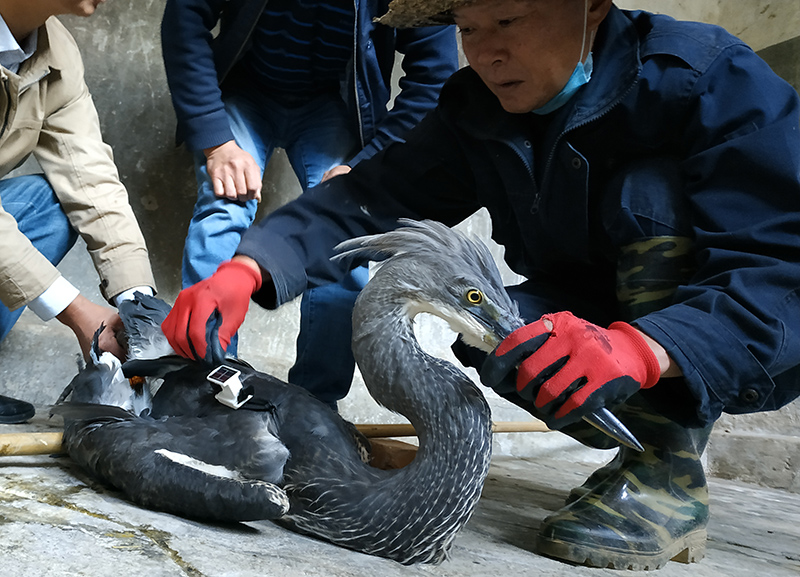On November 11, in the Gengga countryside in China, A group of people was watching carefully transporting one of the rarest birds to safety.
Able to capture and carry a fully grown White-bellied Heron
The second-largest of herons has an approximate wingspan of 2 meters) isn’t an easy task, however, this bird was tired and weak. The rescuers had seen it being chased along the banks of the Zhenkang River, in an area where it had not been observed in the last few years and has been thought to be to be extinct locally. How Long Do Birds Live
But local conservationists did not give up hope and, over the last several years Synchronicity Earth has supported initiatives to raise awareness of the bird among the communities of this region. It was therefore a proof of goodwill that the local population was aware of the species and saved the bird and brought it to the local authorities.
The forest police called Prof. Han Lianxian, the Chinese coordinator of the White-bellied Heron Working Group and he immediately took action to coordinate efforts to save the bird, recover it and then release it. bird.More
International collaboration for an injured bird
The White-bellied Heron Working Group was formed with the help of Synchronicity Earth to bring together all the organizations and individuals throughout the world to share their knowledge and provide the Critically endangered species its best chance of survival.
Through the network, Synchronicity Earth was able to swiftly connect Professor Han with experts in the captive care of herons. These experts gave precise guidance regarding feeding and care that was swiftly executed.
This meant that after just a couple of days, this bird, which is known to be difficult to manage in captivity was able to improve its strength and was now ready for release. We were also able to find a vet who had expertise in similar species to visit China after leaving
Singapore Zoo to do a complete health assessment of the bird and to provide assistance when they released it into the area where it was discovered. A satellite transmitter, as well as a leg ring, was also put on the bird in order to identify it as well as provide required information on its movement.
Every single sighting counts
There is a belief that there are less than 60 White-bellied Herons remaining. Every encounter boosts local conservation efforts and conservationists working to save the species. Every single heron counts.
The heron in question is the third sighting in the last year that a heron has been that was sighted in an area that was believed to be extinct. This could mean there are more wild birds than initially thought.
After the news that there was a White-bellied Heron was captured on a camera trap in an area that was previously undiscovered in India and we were told in November that a White-bellied Heron was observed and captured by an expert guide in Manas National Park, India in another region where the bird hasn’t been seen for many years.
Synchronicity Earth took an active part in convening and assisting efforts to protect the critically endangered White-bellied Heron over the last 5 decades. This has included co-authoring an international conservation strategy, securing funding, and facilitating research and conservation efforts across its range.
We have helped organizations and individuals in enhancing their capacity and have also involved experts from a variety of initiatives developed to safeguard the bird, including captive breeding, the installation of Satellite transmitters as well as remote analysis of habitat as well as field studies.
After five years of coordinated efforts, the range of states and dedicated individuals are starting to be rewarded! The rehabilitation, rescue, and release of this bird injured was a testimony to the value and determination of those who are working to save the issue of this Critically Endangered species.
An unhappy ending
Tragically, just a couple of weeks after the release legs and the satellite’s transmitter were discovered close to the site of release after being taken from the bird by an individual. This suggests that the bird could have been hunted for its meat and the items were removed in order to avoid detection.
Officials are currently looking for a way to identify and prosecute the person responsible for the crime. This is sadly not a typical case for the conservation of species in areas that are highly populated, like East as well as Southeast Asia.
Despite this disappointing outcome, the extraordinary efforts of residents, Chinese officials, Professor Han Lianxian, Baoshan Wildlife Centre, and many others, provide optimism that this endangered species will survive in China.
It is highly probable that the bird wouldn’t have been saved at all had it not been for the collaboration we have previously facilitated with these communities. that’s why we are investing more in the going forward, with the hope of ensuring that any White-bellied Heron which is discovered on the outskirts of China can have a more pleasant conclusion.
We are far from quitting
This year’s new sightings together with other sightings in Bhutan and the efforts of our Bhutanese partners with the Royal Society for the Protection of Nature, to create an indoor nesting facility to breed the birds give hope to those who are concerned and strive to protect this species.
More information will be announced soon which will include an opening date for the breeding center in 2020, and the first attempts to capture wild birds to improve the viability and survival of the species.
We would like to express our sincere gratitude to the donors who have helped us with this project by donating to the Asian Species program across Bhutan, China, and India.
Also, Read

